Whale Watching in Iceland: Your Guide
Vast, graceful, and mysterious, whales are probably some of the most majestic creatures on the planet. And there’s no better place in the world to see them than in Iceland.
August 19, 2022
Whale Watching in Iceland: Your Guide
Vast, graceful, and mysterious, whales are probably some of the most majestic creatures on the planet. And there’s no better place in the world to see them than in Iceland.
August 19, 2022
In this article, we want to share with you some of the joys of whale-watching in Iceland. We’ll show you some of the species of whales you can witness, as well as some of the best places you can go on the island for a whale-watching tour.
Whale-watching tours in Iceland are the best way to see these glorious animals. Read on to find out all you need to know.
Why is Iceland such a great place to see whales?
It’s no exaggeration to say that Iceland is one of the best places in the world to see whales. Awesome scenery and spectacular coastlines make the location special enough. But the whales head here largely because of Iceland’s unique position in the middle of the North Atlantic.
Throughout the year, whales travel massive distances in search for food. One of the places they find it is off the coast of Iceland.
That’s thanks to two major ocean currents that create a mix of warm and cooler waters. These conditions attract abundant supplies of krill and fish to Iceland’s fjords—and these make a tasty meal for the whales.
As a result, over 20 different species of cetaceans—the group of mammals including whales, dolphins, and porpoises—make Iceland’s waters their home at different times throughout the year. This means that visitors to Iceland have an incredibly high chance of catching a glimpse of them.
What whale species can you see in Iceland?
Of the more than 20 cetacean species in our waters, there are as many as 12 types of whale that you can see in Iceland throughout the year. But some species are a lot more common than others.
Here are some of Iceland’s whales that you’re most likely to see on a whale-watching tour.
Minke whales
Minke whales are the most common species of whale that can be found in Iceland’s waters. Typically coming to Iceland during the summer, many often stay long into the autumn and winter.
While they’re quite a shy species, there are estimated to be between 10,000 and 15,000 minke whales around the coasts of Iceland. That means you have a really good chance of seeing them.
However, compared to other species of whale, minke are quite small—typically measuring around 9 metres (30 feet) in length.
Orcas
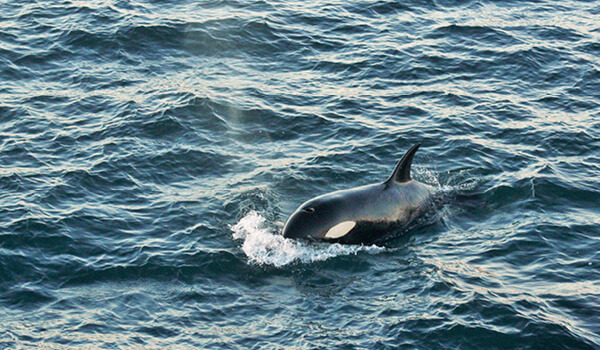
More commonly known as “killer whales” in English, orcas have a mean reputation. But the nickname is inaccurate in two different ways.
Firstly, orcas aren’t particularly aggressive animals, at least where humans are concerned. Rather, they’re curious, inquisitive, and often approach boats to see what’s going on.
That said, orcas are incredibly successful hunters. They live in groups known as pods that can include up to 40 individuals. They’re known to hunt everything from fish to large marine mammals, and they’ve even been known to eat great white sharks.
Secondly, these “killer whales” aren’t even whales at all. They’re actually the largest species of dolphin. However, that doesn’t make them any less special.
Humpback whales
It’s always memorable to see a humpback whale. Among all the species of whale, humpbacks are typically the most acrobatic, leaping through the air and slapping together their fins.
Humpbacks come to Iceland throughout the summer (often from as far south as the south Pacific, where they breed). They can be most commonly seen on Iceland whale-watching tours from April to October, particularly from tours from North Iceland.
Like most whales, humpbacks eat krill—and need to eat over a ton of it a day.
Fin whales
The second largest animal that has ever lived on the planet (second only to the blue whale), the mighty fin whale is another species that’s often seen in Iceland’s waters. However, it is endangered—and that’s largely due to whale hunting.
In fact, fin whales were the most hunted species of great whale throughout the 20th century, and they are still occasionally hunted in Iceland too.
They are fast, sleek, and beautiful creatures—and it would be a privilege to see one on a whale-watching tour.
Sei whales
One of the most poorly understood whales, the sei whale is another marine giant. It’s also the fastest of all baleen whales, reaching speeds of about 50 kilometres an hour (31 miles an hour).
Of the 10,000 sei whales found in the north Atlantic, they’re most abundant in the waters between Iceland and Greenland. But they prefer deeper waters, which means that typically you have to go further to find them.
That doesn’t mean that you won’t, however. Typically, they feed at the surface, which can help your chances.
Other species of whale in Iceland
These are not only types of whale you might glimpse while whale-watching in Iceland. Although less common, there’s still a chance you could witness some of these special species.
• Blue whales. The biggest creature ever to have lived on earth, blue whales are truly the kings of the ocean. However, despite their size, they are tricky to find—and Iceland is one of the few places we know they can be spotted.
• Beluga whales. The distinctive white beluga whale lives around the North Atlantic and Arctic oceans—and can occasionally be seen in Icelandic waters. They typically swim in groups of up to hundreds of individuals and are known for their distinctive sounds. (You can also meet two of them at the Whale Sanctuary on the Westman Islands. See below for more.)
• Sperm whales. Recognisable by their flat heads, sperm whales are known to have the largest brain of any animal around. They prefer deeper waters, but you may glimpse them on a whale-watching tour.
• Narwhals. While narwhal sightings in Iceland are rare, it’s possible to see these magical tusked creatures off the far north of the country.
Where to go whale watching in Iceland?
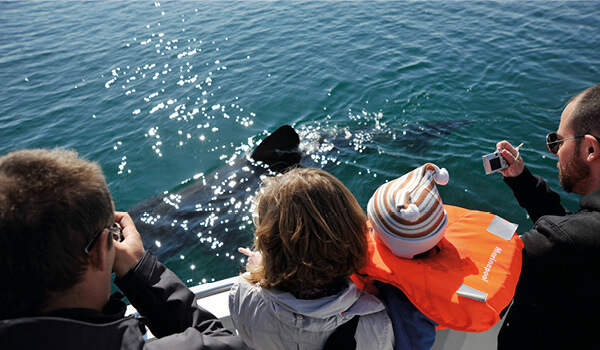
So, now you know what’s out there, where’s the best place in Iceland for a whale-watching experience? The good news is that you have plenty of options.
Reykjavik
As the capital city, Reykjavik is typically the most popular place to go whale-watching in Iceland. It’s convenient, comfortable, and, what’s more, you have a fantastic chance of catching a glimpse of these animals.
Throughout the year, you can see minke whales, humpbacks, different species of dolphin, and much more.
North Iceland
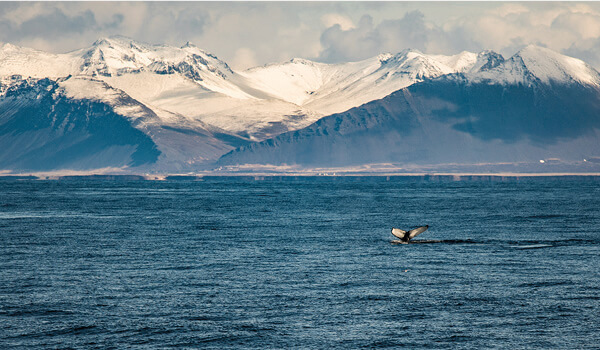
One of the most famous destinations for whale-watching in Iceland is the north coast. Here, the colder waters of the Arctic are warmed in the long fjords and bays.
Two of the major centres of whale watching in North Iceland are the towns of Akureyri and Húsavík. In fact, the town of Húsavik, on Skjálfandi Bay, is often named as the best place to see whales and other marine mammals in all of Europe. Whales are in these waters throughout the year. So, whenever you come, you’re very likely to glimpse an animal or two yourself.
Snæfellsnes peninsula
A particularly scenic spot for whale watching is the Snæfellsnes peninsula, on Iceland’s west coast. Throughout the year, whales, orcas, and dolphins can be seen.
That’s because the Breidafjordur Fjord is one of Iceland’s most important breeding grounds for herring—typically throughout the winter. That makes the winter season a much better time to see orcas in this part of the world.
The tours typically start from the town of Olafsvík. And when you glimpse a whale from here, you’re likely to have sublime landscapes of the peninsula—including glaciers, mountains, and complex coastline—in the distance too.
Whale sanctuary in Iceland
While it’s not an opportunity to see whales in the wild, the Beluga Whale Sanctuary on Heimaey Island can be visited between April and October.
Heimaey Island is one of the Westman Islands, off the south coast of Iceland. In the Sanctuary in Klettsvík Bay, the Sea Life Trust helps to care for and support beluga whales back to fitness. Two beluga whales currently live there—but there is space for up to 10.
It can be a fantastic opportunity to see beluga. However, it may not have the same magic as seeing them in the wild.
When to go whale watching in Iceland?
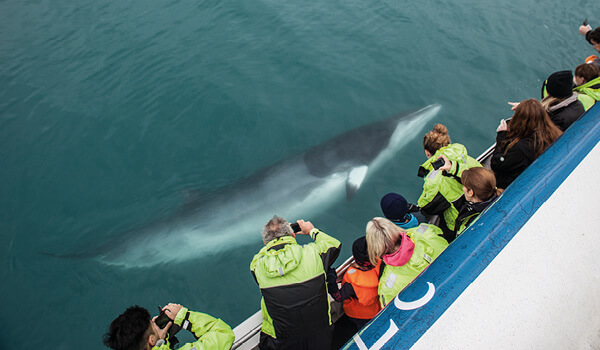
Whales can be seen off the coast of Iceland all year round—meaning any time of year is a good time for whale watching. However, depending on where you go—and which species you would like to see—some seasons are better than others.
Whale watching in summer
Whale watching in Iceland in the summer has some obvious perks.
It’s warmer, making standing on the deck of a boat a lot more comfortable. There are fewer storms, meaning your tour is less likely to be cancelled. And visibility tends to be better, allowing you to better spot the creatures you have come to see.
However, perhaps the more important thing is that there’s simply just a higher number of whales in Iceland’s water during the summer months. Most baleen whales breed in warmer waters during the winter and come north for the summer, making April to October probably the best time to see them.
That means that minke whales, humpbacks, and even blue, fin, and sei whales are all likely to be around Iceland during the summer.
Winter whale watching in Iceland
Of course, whale watching in Iceland during the winter does come with its downsides. It’s cold, possibly windy, and the waters may be quite choppy.However, trust us when we say there are many advantages of whale watching at this time of year too.
Firstly, there are far fewer people around who are likely to take a boat tour during the winter. That gives you a better view whenever any marine creature does pass by.
Then, different whales have different patterns of behaviour. While baleen whales are more commonly seen in Iceland during the summer, orcas are very common in Icelandic waters during the winter months, particularly around the Snæfellsnes peninsula. Similarly, beluga whales are a more common sight in North Iceland during the winter than the summer—as they come further south to avoid the ice.
The final benefit of whale watching in winter doesn’t have anything to do with whales at all. Simply, winter in Iceland is beautiful, breath-taking, and completely special.
What is the best month for whale watching in Iceland?
As we said, the best time for whale watching in Iceland depends on what you want to see. For sheer diversity, the summer months—from April to October—are best. However, if you want to see orca or beluga whales, the winter months are fantastic opportunities too.
Best whale watching tours in Iceland
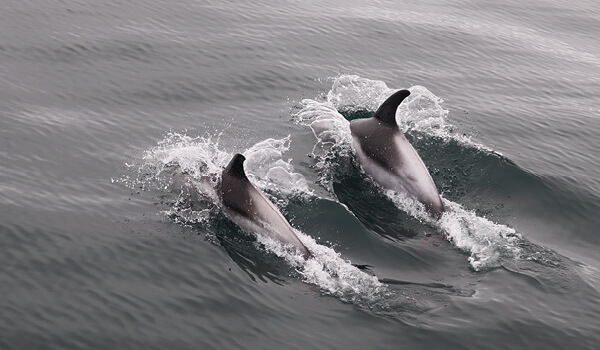
There are many companies out there offering whale watching tours in Iceland. However, whichever you choose, make sure that you’re offered some basic features to guarantee a great experience.
Expert guides are a must, who know exactly where to find these magical creatures. Supplies of extra gear for warmth are highly recommended. And choose a whale-watching tour company that gives you a free return ticket if you don’t see any whales the first time around.
Here’s just a selection of the whale-watching tours we offer at Reykjavik Excursions.
• Whale watching from Reykjavik. From the decks of our trusty vessel, Andrea, you’ll see whales aplenty on our wildlife adventure from Reykjavik. With welcoming interiors, expert guidance, and views over Reykjavik too, it’s a thrilling and comfortable trip. Find out more: Whale Watching from Reykjavik
• Whale watching from Akureyri. The city of Akureyri sits on the banks of the Eyjafjörður fjord, the deepest fjord in Iceland. A whale tour from the city takes you out into the fjord and beyond, to the home of North Iceland’s humpback whales. Find out more: Whale Watching from Akureyri
• RIB adventures. Alternatively, take a high-speed whale tour on a rigid inflatable boat (RIB) from Reykjavik. Much smaller vessels, these can take you right up close to the majestic creatures, while ensuring the safety of both you and the whales. Find out more: RIB Express tour
We offer many more tours from both Reykjavik and Akureyri, where you can try your hand at angling, see puffins, or combine your whale-watching experience with a visit to Reykjavik’s Whales of Iceland exhibition.
Discover all of the options and book here: Whale watching tours in Iceland
See other wildlife in Iceland
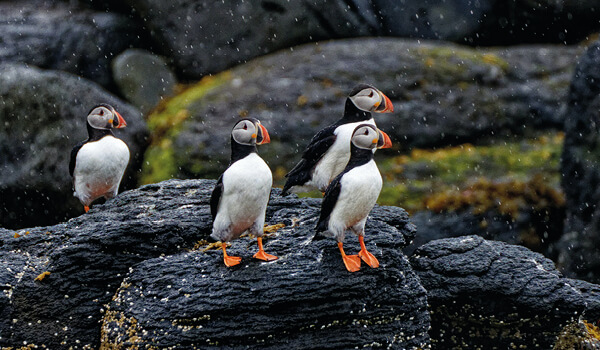
Whenever you decide to take to the waters off Iceland, whales are not the only things you’ll see. In fact, Iceland’s coasts are teeming with wildlife. In the air and in the ocean, you can glimpse all manner of incredible creatures that are no less special than whales themselves. Here’s just a taste of what you can see.
• Puffins. The adorable orange-beaked birds are one of the best-known of Iceland’s creatures. And with good reason. In fact, Iceland is home to more than 60% of the Atlantic’s entire population. Find them on the Westman Islands, or closer to Reykjavik on the islands of Akurey and Lundey.
• Seals. The two species of seal that make the coasts of Iceland their permanent home are grey seals and harbour (or common) seals. You can see them lounging on rocky reefs, beaches, or skerries all around our country—or glimpse them in the water.
• Dolphins. We mentioned orca above (the species of dolphin often confused with whales), but there are many other types of dolphin around the coasts of Iceland. The white-beaked dolphin is the most common, but you can see bottlenose dolphins, striped dolphins, and pilot whales on whale-watching trips too.
• Other birds. Iceland’s skies are home to oystercatchers, golden plover, arctic terns, gyrfalcon, and many more species. Take a birdwatching tour or just head out to the coast with a pair of binoculars.
Travel tips for whale watching in Iceland
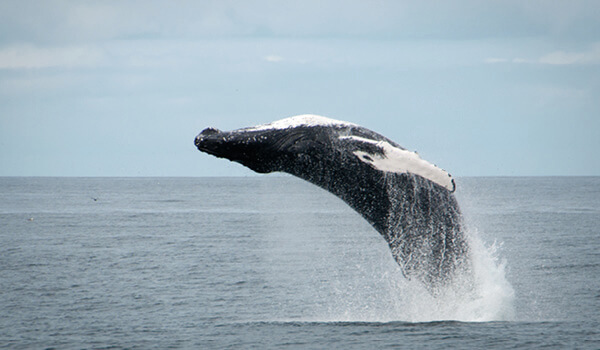
Finally, before you set sail on a whale watching tour, what do you need to bring with you? The key thing will be to stay warm and have the most comfortable and memorable experience possible. That means packing the following:
• Waterproof jacket. In summer or winter, rain’s always a risk. And what’s more, sea spray and the splashing of whales can get you wet too. Always pack a waterproof!
• Lots of warm layers. From bracing winds to glorious sunshine, you can experience all sorts of different weather on an Icelandic whale tour. It’s best to dress so that you can put extra layers on (or take them off) depending on the temperature.
• Hat and gloves. On a typical whale-watching tour, you’re going to be at sea for about 3 hours. It can be cold, and you don’t want to miss out on seeing whales by warming up indoors. Make sure you have enough to keep you comfortable.
• Camera. Seeing a whale may be one of the most special moments of your life—and you’ll want to keep a document of it forever. A camera or phone will be a must.
• Binoculars. Finally, the smart whale-watcher will bring a tool to see these animals up close.
Book a whale watching tour in Iceland with Reykjavik Excursions
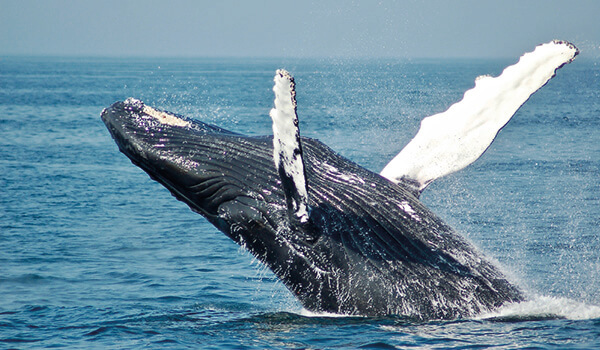
Come and witness whales in the wild on an Icelandic whale-watching tour. With stunning scenery and abundant marine life, a trip to the sea is a truly unforgettable experience.
At Reykjavik Excursions, we offer whale-watching tours to suit every taste, travel style, and season. Whether you set sail from Reykjavik or North Iceland, we’ll supply you with everything you need to stay warm and fully enjoy your experience. We’ll also give you a return ticket if you don’t see any whales.
Alternatively, if you want to stay on dry land, we can organise tours across Iceland—from the Golden Circle to the Highlands of Iceland. We’ll help you to get to where you need to be in comfort and style.
Want to see whales for yourself? Book your whale watching and puffin tours in Iceland with Reykjavik Excursions.
REYKJAVIK EXCURSIONS BLOG
Get inspired! Information and tips and must see places in Iceland, fun facts, customs and more.
The Silver Circle of West Iceland - Your Guide
You’ve heard of the Golden Circle, but here’s why you should head to Iceland’s western region to explore the msytical Silver Circle tour route.
Read BlogWhale Watching in Iceland: Your Guide
Vast, graceful, and mysterious, whales are probably some of the most majestic creatures on the planet. And there’s no better place in the world to see them than in Iceland.
August 19, 2022
Whale Watching in Iceland: Your Guide
Vast, graceful, and mysterious, whales are probably some of the most majestic creatures on the planet. And there’s no better place in the world to see them than in Iceland.
August 19, 2022
In this article, we want to share with you some of the joys of whale-watching in Iceland. We’ll show you some of the species of whales you can witness, as well as some of the best places you can go on the island for a whale-watching tour.
Whale-watching tours in Iceland are the best way to see these glorious animals. Read on to find out all you need to know.
Why is Iceland such a great place to see whales?
It’s no exaggeration to say that Iceland is one of the best places in the world to see whales. Awesome scenery and spectacular coastlines make the location special enough. But the whales head here largely because of Iceland’s unique position in the middle of the North Atlantic.
Throughout the year, whales travel massive distances in search for food. One of the places they find it is off the coast of Iceland.
That’s thanks to two major ocean currents that create a mix of warm and cooler waters. These conditions attract abundant supplies of krill and fish to Iceland’s fjords—and these make a tasty meal for the whales.
As a result, over 20 different species of cetaceans—the group of mammals including whales, dolphins, and porpoises—make Iceland’s waters their home at different times throughout the year. This means that visitors to Iceland have an incredibly high chance of catching a glimpse of them.
What whale species can you see in Iceland?
Of the more than 20 cetacean species in our waters, there are as many as 12 types of whale that you can see in Iceland throughout the year. But some species are a lot more common than others.
Here are some of Iceland’s whales that you’re most likely to see on a whale-watching tour.
Minke whales
Minke whales are the most common species of whale that can be found in Iceland’s waters. Typically coming to Iceland during the summer, many often stay long into the autumn and winter.
While they’re quite a shy species, there are estimated to be between 10,000 and 15,000 minke whales around the coasts of Iceland. That means you have a really good chance of seeing them.
However, compared to other species of whale, minke are quite small—typically measuring around 9 metres (30 feet) in length.
Orcas

More commonly known as “killer whales” in English, orcas have a mean reputation. But the nickname is inaccurate in two different ways.
Firstly, orcas aren’t particularly aggressive animals, at least where humans are concerned. Rather, they’re curious, inquisitive, and often approach boats to see what’s going on.
That said, orcas are incredibly successful hunters. They live in groups known as pods that can include up to 40 individuals. They’re known to hunt everything from fish to large marine mammals, and they’ve even been known to eat great white sharks.
Secondly, these “killer whales” aren’t even whales at all. They’re actually the largest species of dolphin. However, that doesn’t make them any less special.
Humpback whales
It’s always memorable to see a humpback whale. Among all the species of whale, humpbacks are typically the most acrobatic, leaping through the air and slapping together their fins.
Humpbacks come to Iceland throughout the summer (often from as far south as the south Pacific, where they breed). They can be most commonly seen on Iceland whale-watching tours from April to October, particularly from tours from North Iceland.
Like most whales, humpbacks eat krill—and need to eat over a ton of it a day.
Fin whales
The second largest animal that has ever lived on the planet (second only to the blue whale), the mighty fin whale is another species that’s often seen in Iceland’s waters. However, it is endangered—and that’s largely due to whale hunting.
In fact, fin whales were the most hunted species of great whale throughout the 20th century, and they are still occasionally hunted in Iceland too.
They are fast, sleek, and beautiful creatures—and it would be a privilege to see one on a whale-watching tour.
Sei whales
One of the most poorly understood whales, the sei whale is another marine giant. It’s also the fastest of all baleen whales, reaching speeds of about 50 kilometres an hour (31 miles an hour).
Of the 10,000 sei whales found in the north Atlantic, they’re most abundant in the waters between Iceland and Greenland. But they prefer deeper waters, which means that typically you have to go further to find them.
That doesn’t mean that you won’t, however. Typically, they feed at the surface, which can help your chances.
Other species of whale in Iceland
These are not only types of whale you might glimpse while whale-watching in Iceland. Although less common, there’s still a chance you could witness some of these special species.
• Blue whales. The biggest creature ever to have lived on earth, blue whales are truly the kings of the ocean. However, despite their size, they are tricky to find—and Iceland is one of the few places we know they can be spotted.
• Beluga whales. The distinctive white beluga whale lives around the North Atlantic and Arctic oceans—and can occasionally be seen in Icelandic waters. They typically swim in groups of up to hundreds of individuals and are known for their distinctive sounds. (You can also meet two of them at the Whale Sanctuary on the Westman Islands. See below for more.)
• Sperm whales. Recognisable by their flat heads, sperm whales are known to have the largest brain of any animal around. They prefer deeper waters, but you may glimpse them on a whale-watching tour.
• Narwhals. While narwhal sightings in Iceland are rare, it’s possible to see these magical tusked creatures off the far north of the country.
Where to go whale watching in Iceland?

So, now you know what’s out there, where’s the best place in Iceland for a whale-watching experience? The good news is that you have plenty of options.
Reykjavik
As the capital city, Reykjavik is typically the most popular place to go whale-watching in Iceland. It’s convenient, comfortable, and, what’s more, you have a fantastic chance of catching a glimpse of these animals.
Throughout the year, you can see minke whales, humpbacks, different species of dolphin, and much more.
North Iceland

One of the most famous destinations for whale-watching in Iceland is the north coast. Here, the colder waters of the Arctic are warmed in the long fjords and bays.
Two of the major centres of whale watching in North Iceland are the towns of Akureyri and Húsavík. In fact, the town of Húsavik, on Skjálfandi Bay, is often named as the best place to see whales and other marine mammals in all of Europe. Whales are in these waters throughout the year. So, whenever you come, you’re very likely to glimpse an animal or two yourself.
Snæfellsnes peninsula
A particularly scenic spot for whale watching is the Snæfellsnes peninsula, on Iceland’s west coast. Throughout the year, whales, orcas, and dolphins can be seen.
That’s because the Breidafjordur Fjord is one of Iceland’s most important breeding grounds for herring—typically throughout the winter. That makes the winter season a much better time to see orcas in this part of the world.
The tours typically start from the town of Olafsvík. And when you glimpse a whale from here, you’re likely to have sublime landscapes of the peninsula—including glaciers, mountains, and complex coastline—in the distance too.
Whale sanctuary in Iceland
While it’s not an opportunity to see whales in the wild, the Beluga Whale Sanctuary on Heimaey Island can be visited between April and October.
Heimaey Island is one of the Westman Islands, off the south coast of Iceland. In the Sanctuary in Klettsvík Bay, the Sea Life Trust helps to care for and support beluga whales back to fitness. Two beluga whales currently live there—but there is space for up to 10.
It can be a fantastic opportunity to see beluga. However, it may not have the same magic as seeing them in the wild.
When to go whale watching in Iceland?

Whales can be seen off the coast of Iceland all year round—meaning any time of year is a good time for whale watching. However, depending on where you go—and which species you would like to see—some seasons are better than others.
Whale watching in summer
Whale watching in Iceland in the summer has some obvious perks.
It’s warmer, making standing on the deck of a boat a lot more comfortable. There are fewer storms, meaning your tour is less likely to be cancelled. And visibility tends to be better, allowing you to better spot the creatures you have come to see.
However, perhaps the more important thing is that there’s simply just a higher number of whales in Iceland’s water during the summer months. Most baleen whales breed in warmer waters during the winter and come north for the summer, making April to October probably the best time to see them.
That means that minke whales, humpbacks, and even blue, fin, and sei whales are all likely to be around Iceland during the summer.
Winter whale watching in Iceland
Of course, whale watching in Iceland during the winter does come with its downsides. It’s cold, possibly windy, and the waters may be quite choppy.However, trust us when we say there are many advantages of whale watching at this time of year too.
Firstly, there are far fewer people around who are likely to take a boat tour during the winter. That gives you a better view whenever any marine creature does pass by.
Then, different whales have different patterns of behaviour. While baleen whales are more commonly seen in Iceland during the summer, orcas are very common in Icelandic waters during the winter months, particularly around the Snæfellsnes peninsula. Similarly, beluga whales are a more common sight in North Iceland during the winter than the summer—as they come further south to avoid the ice.
The final benefit of whale watching in winter doesn’t have anything to do with whales at all. Simply, winter in Iceland is beautiful, breath-taking, and completely special.
What is the best month for whale watching in Iceland?
As we said, the best time for whale watching in Iceland depends on what you want to see. For sheer diversity, the summer months—from April to October—are best. However, if you want to see orca or beluga whales, the winter months are fantastic opportunities too.
Best whale watching tours in Iceland

There are many companies out there offering whale watching tours in Iceland. However, whichever you choose, make sure that you’re offered some basic features to guarantee a great experience.
Expert guides are a must, who know exactly where to find these magical creatures. Supplies of extra gear for warmth are highly recommended. And choose a whale-watching tour company that gives you a free return ticket if you don’t see any whales the first time around.
Here’s just a selection of the whale-watching tours we offer at Reykjavik Excursions.
• Whale watching from Reykjavik. From the decks of our trusty vessel, Andrea, you’ll see whales aplenty on our wildlife adventure from Reykjavik. With welcoming interiors, expert guidance, and views over Reykjavik too, it’s a thrilling and comfortable trip. Find out more: Whale Watching from Reykjavik
• Whale watching from Akureyri. The city of Akureyri sits on the banks of the Eyjafjörður fjord, the deepest fjord in Iceland. A whale tour from the city takes you out into the fjord and beyond, to the home of North Iceland’s humpback whales. Find out more: Whale Watching from Akureyri
• RIB adventures. Alternatively, take a high-speed whale tour on a rigid inflatable boat (RIB) from Reykjavik. Much smaller vessels, these can take you right up close to the majestic creatures, while ensuring the safety of both you and the whales. Find out more: RIB Express tour
We offer many more tours from both Reykjavik and Akureyri, where you can try your hand at angling, see puffins, or combine your whale-watching experience with a visit to Reykjavik’s Whales of Iceland exhibition.
Discover all of the options and book here: Whale watching tours in Iceland
See other wildlife in Iceland

Whenever you decide to take to the waters off Iceland, whales are not the only things you’ll see. In fact, Iceland’s coasts are teeming with wildlife. In the air and in the ocean, you can glimpse all manner of incredible creatures that are no less special than whales themselves. Here’s just a taste of what you can see.
• Puffins. The adorable orange-beaked birds are one of the best-known of Iceland’s creatures. And with good reason. In fact, Iceland is home to more than 60% of the Atlantic’s entire population. Find them on the Westman Islands, or closer to Reykjavik on the islands of Akurey and Lundey.
• Seals. The two species of seal that make the coasts of Iceland their permanent home are grey seals and harbour (or common) seals. You can see them lounging on rocky reefs, beaches, or skerries all around our country—or glimpse them in the water.
• Dolphins. We mentioned orca above (the species of dolphin often confused with whales), but there are many other types of dolphin around the coasts of Iceland. The white-beaked dolphin is the most common, but you can see bottlenose dolphins, striped dolphins, and pilot whales on whale-watching trips too.
• Other birds. Iceland’s skies are home to oystercatchers, golden plover, arctic terns, gyrfalcon, and many more species. Take a birdwatching tour or just head out to the coast with a pair of binoculars.
Travel tips for whale watching in Iceland

Finally, before you set sail on a whale watching tour, what do you need to bring with you? The key thing will be to stay warm and have the most comfortable and memorable experience possible. That means packing the following:
• Waterproof jacket. In summer or winter, rain’s always a risk. And what’s more, sea spray and the splashing of whales can get you wet too. Always pack a waterproof!
• Lots of warm layers. From bracing winds to glorious sunshine, you can experience all sorts of different weather on an Icelandic whale tour. It’s best to dress so that you can put extra layers on (or take them off) depending on the temperature.
• Hat and gloves. On a typical whale-watching tour, you’re going to be at sea for about 3 hours. It can be cold, and you don’t want to miss out on seeing whales by warming up indoors. Make sure you have enough to keep you comfortable.
• Camera. Seeing a whale may be one of the most special moments of your life—and you’ll want to keep a document of it forever. A camera or phone will be a must.
• Binoculars. Finally, the smart whale-watcher will bring a tool to see these animals up close.
Book a whale watching tour in Iceland with Reykjavik Excursions

Come and witness whales in the wild on an Icelandic whale-watching tour. With stunning scenery and abundant marine life, a trip to the sea is a truly unforgettable experience.
At Reykjavik Excursions, we offer whale-watching tours to suit every taste, travel style, and season. Whether you set sail from Reykjavik or North Iceland, we’ll supply you with everything you need to stay warm and fully enjoy your experience. We’ll also give you a return ticket if you don’t see any whales.
Alternatively, if you want to stay on dry land, we can organise tours across Iceland—from the Golden Circle to the Highlands of Iceland. We’ll help you to get to where you need to be in comfort and style.
Want to see whales for yourself? Book your whale watching and puffin tours in Iceland with Reykjavik Excursions.
REYKJAVIK EXCURSIONS BLOG
Get inspired! Information and tips and must see places in Iceland, fun facts, customs and more.
The Silver Circle of West Iceland - Your Guide
You’ve heard of the Golden Circle, but here’s why you should head to Iceland’s western region to explore the msytical Silver Circle tour route.
Read Blog